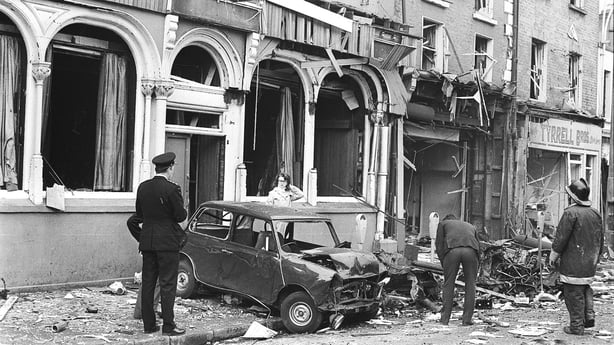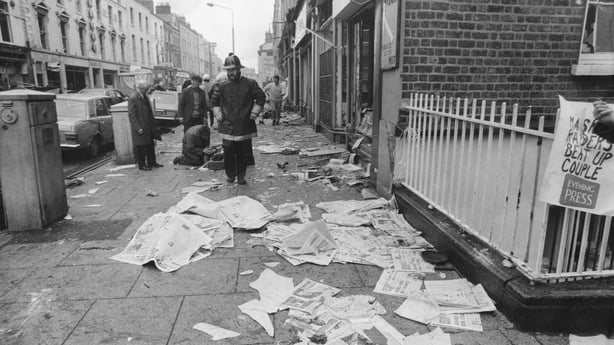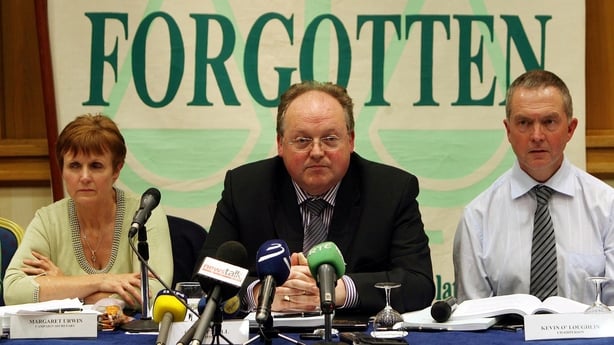Four no-warning car bombs in the space of less than 90 minutes, including three in six minutes went off 50 years ago during rush hour in Dublin city centre and Monaghan town.
The lives of 34 people, including an unborn baby, suddenly ended.
Among the victims were a five-month-old child and her entire family, and an 80-year-old World War I veteran.
More than 250 more innocent people were injured.
Half a century on from the single worst day of fatalities in the history of the Troubles, the emotional scars of what happened and the answers still being sought are evidenced in the words and memories of the people affected.
Previous bomb attacks had taken place in Dublin in 1972 and 1973, killing three people and injuring 185.
However, the sheer scale of the 17 May 1974 Dublin-Monaghan bombings in a very real sense shattered the already fragile illusion that the violence of the Troubles was largely confined to north of the border.

In doing so, they also again underlined how innocent lives could be taken and forever changed, in the blink of an eye.
At 5.28pm on a sunny afternoon, Dublin city was awash with people making their way home from work or heading out for an evening with the crowds walking added to by the fact a bus strike was in operation.
Within seconds the first of three "no-warning" car bombs in Dublin, and a fourth in Monaghan town later that evening, exploded.
The first car bomb detonated at Parnell Street, killing ten people including five-month-old Anne Marie O'Brien, her 17-month-old sister Jacqueline and their parents John and Anna O'Brien.
World War I veteran John Dargle, 80, was also killed in the blast.

The bomb had been planted in a car, which was parked near the Welcome Inn pub and Barry's supermarket, both of which were located close to petrol pumps.
The car, a green 1970 Hillman Avenger, had been hijacked in Belfast earlier that day.
Two minutes later at 5.30pm, with the city still in shock, a second car bomb exploded less than 800m away at Talbot Street's intersection with Gardiner Street, just off O'Connell Street and in the heart of Dublin city.
It killed 14 more people, including Colette Doherty who was nine months pregnant.
This time the bomb was located in a blue Ford Escort, which like the earlier vehicle had also been stolen in Belfast, this time the docks area, that morning.
Within two minutes, at 5.32pm, a third car bomb exploded less than 1 kilometre away at South Leinster Street near Trinity College and Leinster House, killing two women instantly.
A blue Austin 1800 car, also hijacked in Belfast that morning and this time from a taxi firm, had contained the bomb.
With news of what had happened spreading across the country, people attempted to come to terms with the sudden and completely unexpected attacks.
They included many people in Monaghan town, which within 90 minutes would face its own devastating day.
At 6.58pm, outside Greacen's pub in the border town, a fourth bomb exploded, taking the lives of seven more innocent people, five of whom died at the scene and two more in the weeks that followed.
The bomb was hidden in a green 1966 Hillman Minx.
Like the three Dublin bombs, the car containing the Monaghan bomb had been stolen hours earlier and driven over the border, this time from Portadown.
Watch: Liam Cosgrave condemns Dublin and Monaghan bombings
We need your consent to load this rte-player contentWe use rte-player to manage extra content that can set cookies on your device and collect data about your activity. Please review their details and accept them to load the content.Manage Preferences
In the immediate aftermath of the attacks, then taoiseach and Fine Gael leader Liam Cosgrave told the Dáil: "The blood of the innocent victims of last Friday's outrage and the victims of similar outrages in the north and in England, is on the hands of every man who has fired a gun or discharged a bomb in furtherance of the present campaign of violence in these islands... violence cannot be contained in neat compartments and justified in one case but not in another."
His words were echoed by then British prime minister Harold Wilson, who said the "horrific" attacks show that "once again it is the defenceless civilian population who will suffer the consequences of these mindless and savage terrorist attacks".
Meanwhile, then chief of the then Northern Ireland Executive and former Ulster Unionist Party leader Brian Faulkner, also sent a message to the taoiseach, saying: "We in Northern Ireland, who have had to endure so much suffering and death in recent years, can appreciate fully the tragedy of those who have been struck down and the grief of those who have been bereaved in injured in your capital.
"Whatever the differences of opinion which may exist in other matters, I believe the responsible people in Northern Ireland and Éire alike want to see this island rid forever of the evil forces which are guilty of such acts."

However, the aftermath of the events of 17 May 1974 did not end there, with questions continuing to this day over who specifically was responsible for what happened.
While it was widely suspected that loyalists were responsible for what happened, it took until 1993, 19 years after the bombings, for the Ulster Volunteer Force to confirm it was involved in the attacks.
Although no direct reason for the attacks was put forward, it was noted that they occurred on the third day of a high-profile strike by unionist workers in Northern Ireland opposed to the Sunningdale Power-sharing Agreement.
The deal had been signed in December 1973 and set out both the establishment of a Northern Ireland Assembly and a role for Dublin in the running of Northern Ireland.
The strike ultimately collapsed the deal.
In 1996, three years after the UVF's admission of involvement and with no one charged over the bombings, relatives of the victims of the attacks set up a group called Justice for the Forgotten and called for a public inquiry.
In August 1999, following a number of legal battles, the Irish Victims Commissioner John Wilson said a behind-closed-doors judicial inquiry would be the most appropriate response.
In December 1999, then taoiseach Bertie Ahern appointed Mr Justice Liam Hamilton to lead the inquiry before he was replaced in October 2000 by Mr Justice Henry Barron.
This inquiry concluded in late 2003 and said in its view that the bombings were carried out by two loyalist groups in Belfast and the Portadown-Lurgan area and that it was likely that individual members of the then Royal Ulster Constabulary (RUC) and the Ulster Defence Regiment may have had knowledge of events.
However, any claim of collusion between loyalist paramilitaries and the RUC or other official bodies at the time has been rejected by those groups.

In May 2005, following the Barron report, a commission of investigation was established, with senior counsel Patrick McEntee as its sole member.
Its final report in April 2007 gave no definitive finding but it was critical of how garda records, notes and evidence, including a registration plate of the Monaghan bomb car with a fingerprint on it, had been lost and said inadequate information had been provided by British officials.
The findings from the inquiry are currently being examined, alongside other Troubles legacy cases, as part of Operation Denton and led by the former chief constable of the police service in Scotland, Iain Livingstone.
The investigation is due to conclude its work next year.







